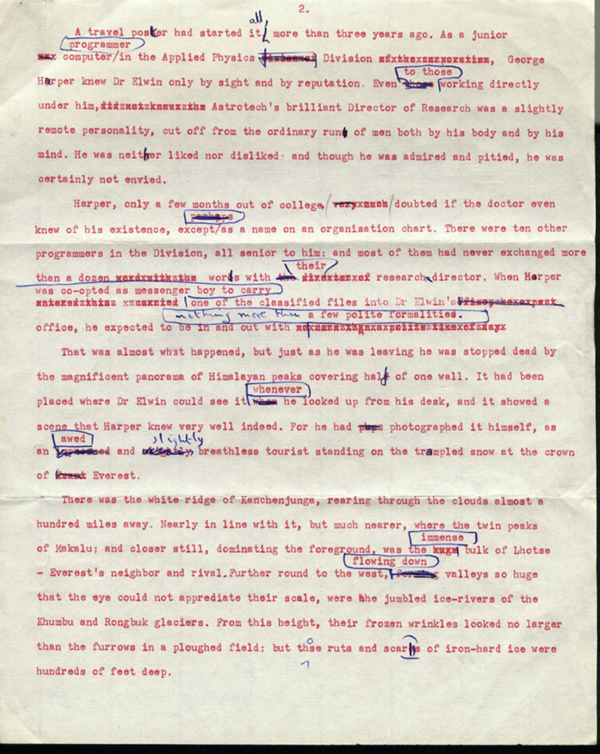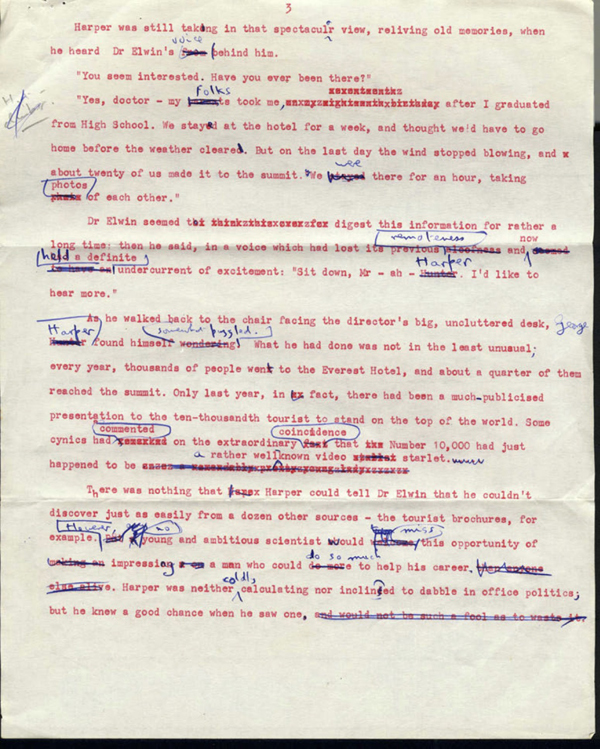

Arthur C. Clarke Edited Typescript, 1966
Sir Arthur Charles Clarke was born in Somerset England in 1917 and was interested in science fiction from a young age. He started writing while he was still a teenager, and joined the British Interplanetary Society (BIS) at the age of seventeen. Despite his obvious high intelligence, Clarke was unable to attend University due to a lack of funding and instead took a job working as an auditor for the British Civil Service until the beginning of World War II. His time in the Royal Air Force as a radar instructor and technician during the war increased his passion for space exploration and thirst for knowledge and he continued writing stories and articles in his spare time. He began selling his short stories to science fiction magazines both in the UK and the US starting in 1946, and, as a result, was made chairman of the BIS from 1946-47 and again from 1951-53.In 1948, Clarke received his long-awaited degree from King’s College in London where he specialized in physics and mathematics. After graduation, he finished two non-fiction works despite his full time job working as editor for a technical magazine. Around this time he also wrote several novels with storylines about the first flight to the moon, the colonization of Mars, and the first contact with aliens, among other themes. Also in the 1950s, Clarke wrote two short stories called, “The Nine Billion Names of God,” and “The Star,” both of which today are viewed as classics in the genre of science fiction. Even after permanently relocating to Sri Lanka in 1956 and embarking on a second career in underwater photography, Clarke continued to produce ground-breaking science fiction to great acclaim.
In 1964, Clarke was approached by director Stanley Kubrick about a project to adapt one of his earlier stories, “The Sentinel,” into a film. The result was the hugely successful 2001: A Space Odyssey which was nominated for an Academy Award and considered by many film critics today to be one of the greatest films ever made. The accolades continued to pile up for Clarke into the 1970s and 1980s, and he eventually received too many awards and honors to list here. He was awarded a Knight Bachelor in 2000.
So, what is Clarke’s connection with the de Grummond Collection?
Arthur C. Clarke penned several children’s books early in his career. In 1966, de Grummond Collection founder Dr. Lena Y. de Grummond wrote him a letter soliciting his manuscripts for these books but found, unfortunately, that they were no longer in his possession. In response to her letter, and as a “consolation prize” of sorts, Sir Arthur sent Dr. de Grummond two pages of a typescript from “The Cruel Sky,” a piece that was eventually published as part of a short story compilation entitled The Wind from the Sun: Stories of the Space Age. Although the compilation was officially published in 1972, the manuscript itself is annotated “20 November 1966,” and was sent to the Collection in 1970. In addition to the manuscript pages, the de Grummond Collection received several pieces of correspondence from Clarke until his death in 2008. The Arthur C. Clarke Papers and 31 of his books are housed in the de Grummond Children’s Literature Collection and can be viewed in the reading room in McCain Library (Room 305), Monday through Friday from 9 a.m. to 4 p.m.
Source:
Gregersen, Erik. “Arthur C. Clarke.” Encyclopædia Britannica, Encyclopædia Britannica, Inc., 12 Mar. 2018, www.britannica.com/biography/Arthur-C-Clarke.


Text by Danielle Bishop Stoulig, Assistant Curator of the de Grummond Children’s Literature Collection.